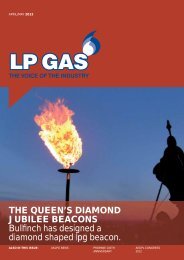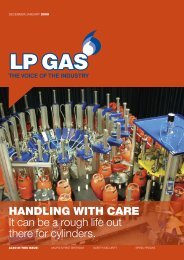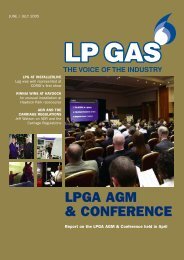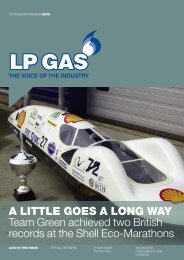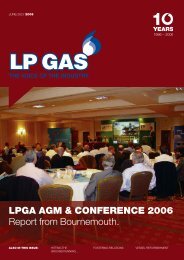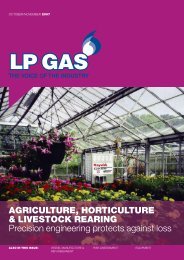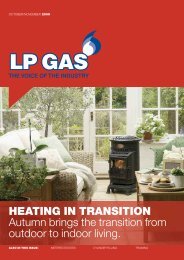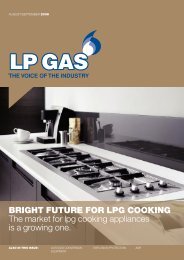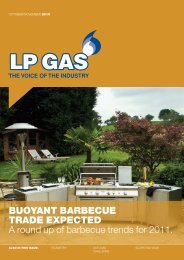C2572 02 Apr-May 06 AW - LP Gas Magazine
C2572 02 Apr-May 06 AW - LP Gas Magazine
C2572 02 Apr-May 06 AW - LP Gas Magazine
You also want an ePaper? Increase the reach of your titles
YUMPU automatically turns print PDFs into web optimized ePapers that Google loves.
AUTOGAS CONVERSION EQUIPMENT<br />
Toroidal lpg tanks in the computer controlled paintshop.<br />
SAFETY IS PARAMOUNT AT WVM<br />
Dutch company, Witte van Moort, has been making lpg tanks since 1974. It now manufactures<br />
54 different types of lpg tank and has capacity for an annual production of 100,000 units.<br />
HKL <strong>Gas</strong>power Ltd has been<br />
purchasing and distributing WVM<br />
pressure vessels in the UK for over<br />
20 years.<br />
“The main reason we have opted<br />
to stock these tanks for so long is<br />
down to a number of reasons,<br />
quality being the main one,” said<br />
Stuart Bradley, general manager at<br />
HKL. “Generally, in the UK, WVM is<br />
still regarded as the premium tank<br />
brand, despite great competition<br />
from some other manufacturers with<br />
similar products. The tanks are also<br />
four-hole orientated, offering<br />
maximum reliability and safety, and<br />
giving peace of mind to us as a<br />
company to confidently sell the<br />
product.<br />
“There are two main marketplaces<br />
in which we sell WVM tanks –<br />
predominantly, the thriving UK lpg<br />
automotive conversion sector, but<br />
also to a number of forklift truck<br />
dealers and manufacturers.<br />
“We are happy to continue<br />
working with WVM for the<br />
foreseeable future and stock a full<br />
and comprehensive range of its<br />
product line here in Birmingham.”<br />
In the 1950s, Witte van Moort<br />
began manufacturing children’s<br />
bicycles, and has since progressed<br />
to mopeds, components for central<br />
heating systems and, in 1974, in<br />
cooperation with a Shell subsidiary;<br />
it began to design lpg tanks.<br />
Initially, it made six types of tanks,<br />
and this has now increased to 54<br />
varieties for different models of cars<br />
and forklift trucks, made in the lpg<br />
department of Witte van Moort’s<br />
20,000m2 factory in Vriezenveen,<br />
Holland. The tanks are each<br />
hydraulically tested to 30-bar.<br />
“The Dutch prefer tanks equipped<br />
with four separate accessories – a<br />
mechanical 80% filling valve, a<br />
solenoid takeoff valve, a gauge with<br />
an electronic sensor and a security<br />
spring valve set at 27 bar - primarily<br />
because of their reliability compared<br />
to multivales,” said Henk Borger,<br />
manager of the lpg department at<br />
Witte van Moort.<br />
“Multivalves often have a smaller<br />
capacity than security spring valves<br />
and that’s why, during a fire, the<br />
pressure in the tank rises too much.<br />
Also, filling the tank takes too much<br />
time and the filling capacity is too<br />
low. The electronic filling valve has a<br />
PTC that measure the level of the<br />
liquid and the solenoid valve shuts off<br />
when the liquid level reaches 80%.”<br />
Production of lpg tanks is a<br />
serious business, says Henk. To<br />
homologate the lpg tank, a cycle test<br />
is required to reach 12,000 times a<br />
pressure between 0 and 30-bar.<br />
Then a burst test much reach a<br />
minimum of 67-bar. Witte van Moort<br />
tanks can withstand 80 to 120-bar in<br />
a burst test, depending the shape of<br />
the tank, says the company.<br />
During production, the tanks are<br />
also subjected to mechanical and x-<br />
ray tests. After mounting the valves,<br />
the tanks are finally tested with<br />
compressed air to 11-bar, to be sure<br />
that all the tanks are safe.<br />
“Production quality is Witte van<br />
Moort’s number one priority,” said<br />
Henk. “That’s why a lot of OEMs are<br />
our customers, including Renault,<br />
Volvo, Vauxhall, Volkswagen,<br />
Subaru, and so on.<br />
“Volkswagen AG has performed<br />
quality audits in Poland and Italy to<br />
compare Witte van Moort to other<br />
companies. They were happy with the<br />
results. Witte van Moort was the only<br />
company with enough points to deliver<br />
all brands in the Volkswagen Group.<br />
“We make sure that our assurance<br />
of quality is also available to the<br />
aftermarket.”<br />
The production of lpg tanks needs<br />
a lot of investment, says Henk<br />
Borger. Equipment, such as deep<br />
draw presses, fully robotised<br />
welding machines and hydraulic test<br />
machines, are needed.<br />
“In my opinion, Europe needs one<br />
organisation that controls the national<br />
notified bodies so the customer is<br />
sure that lpg tanks produced in<br />
Europe and lpg tanks that are<br />
imported into Europe all exactly fulfil<br />
the demands of United Nations<br />
Regulation 67.01,” said Henk.<br />
“The Dutch lpg tank market,<br />
including forklift trucks, is about<br />
25,000 tanks per year. We find that<br />
UK customers tend to give less<br />
priority to quality than those from<br />
Holland and other countries.”<br />
Contact Witte van Moort on<br />
+31 546 562444<br />
www.wvm.nl<br />
Ford Transit lpg twin tanks.<br />
PED homologated forklift lpg tanks.<br />
18<br />
<strong>LP</strong> GAS MAGAZINE APRIL/MAY 20<strong>06</strong>




